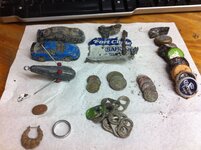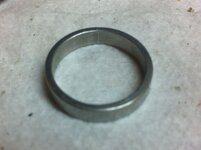Mr.Excavator
Full Member
- Jun 24, 2013
- 199
- 192
- Detector(s) used
- CTX3030 (4)Excal 1000, (2)Garrett Sea Hunter mark II,
(2) E-trac's
- Primary Interest:
- All Treasure Hunting
Hi , Guys
I have been reading a lot of the threads to try an educate myself with the hobbie. I have read that the high tide line is the place to hunt and others swear by the waist/chest deep water hunting.
In my neck of the woods or Beach the lapping waves can be brutal in waist deep water. I have done the local beaches and was off to great start, found quite a bit of stuff even some Gold, but now that I have found something worth wile I want MORE and not just the crappy clad. The high tide lines have been depleted and maybe it is time to go in the water. I guess my questions are in your hypothessis :
Is it best to go at Low tide to do waiding? I would think the heavier gold items may get pulled back out with the surf , is this correct ? Or do you follow the tide back out ?
What is the best depth to be at ? chest, waist, where the waves are easiest ( slow rolling). A certain distance out from shore line?
The last couple of weekends have been a bust with a handful of clad and junk earings on the shore wetsand and high tide lines. I can get the cost of the detectors back one crusty penny at a time.
So some of the long timers in the hobby please chime in with what works for you.
I have been reading a lot of the threads to try an educate myself with the hobbie. I have read that the high tide line is the place to hunt and others swear by the waist/chest deep water hunting.
In my neck of the woods or Beach the lapping waves can be brutal in waist deep water. I have done the local beaches and was off to great start, found quite a bit of stuff even some Gold, but now that I have found something worth wile I want MORE and not just the crappy clad. The high tide lines have been depleted and maybe it is time to go in the water. I guess my questions are in your hypothessis :
Is it best to go at Low tide to do waiding? I would think the heavier gold items may get pulled back out with the surf , is this correct ? Or do you follow the tide back out ?
What is the best depth to be at ? chest, waist, where the waves are easiest ( slow rolling). A certain distance out from shore line?
The last couple of weekends have been a bust with a handful of clad and junk earings on the shore wetsand and high tide lines. I can get the cost of the detectors back one crusty penny at a time.
So some of the long timers in the hobby please chime in with what works for you.
Amazon Forum Fav 👍
Upvote
0











